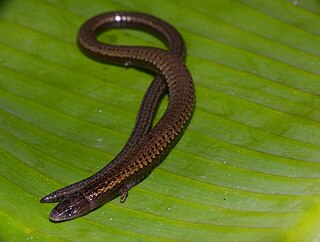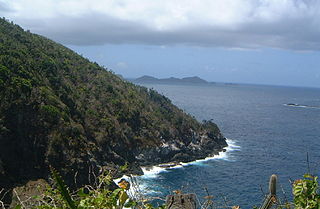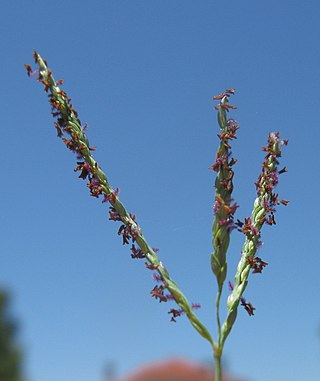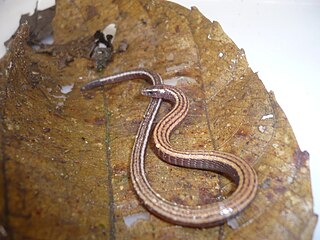
Bachia is a genus of lizards that belong to the spectacled lizards family.

Little Tobago is a small island off the northeastern coast of Tobago, and part of the Republic of Trinidad and Tobago.
Bachia heteropa is a species of "microteiid" lizard in the family Gymnophthalmidae. The species is native to the Caribbean and northern South America. There are two recognized subspecies.

Geina didactyla is a moth of the Pterophoroidea family. It is found in most of Europe, east into Russia.

Digitaria didactyla is a species of grass known by the common names blue couch, Queensland blue couch, blue serangoon grass, green serangoon grass, blue stargrass, and petit gazon. It is native to Mauritius, Réunion, parts of mainland Africa, and Madagascar. It has been introduced widely outside its native range, mainly for use as a pasture and turf grass. It has naturalized in some regions.

Madrasa El Bachia is one of the madrasahs of the medina of Tunis, located in the Rue des Libraires, near the Al-Zaytuna Mosque and in front of the Guachachine Hammam.
Bachia alleni is a species of lizard in the family Gymnophthalmidae. The species is endemic to the southern Caribbean.
Bachia barbouri, also known commonly as Barbour's bachia, is a species of lizard in the family Gymnophthalmidae. The species is endemic to Peru.

Bachia bicolor, the two-colored bachia, is a species of lizard in the family Gymnophthalmidae. It is found in Venezuela and Colombia.
Bachia bresslaui, also known commonly as Bresslau's bachia, is a species of lizard in the family Gymnophthalmidae. The species is native to southern South America.

Bachia dorbignyi, also known commonly as Dorbigny's bachia and lagarto-sem-pata in Brazilian Portuguese, is a species of lizard in the family Gymnophthalmidae. The species is native to central South America.

Bachia flavescens is a species of lizard in the family Gymnophthalmidae. It is found in Colombia, Venezuela, Guyana, Suriname, French Guiana, Tobago, and Brazil.
Bachia guianensis, the Guyana bachia, is a species of lizard in the family Gymnophthalmidae. It is found in Venezuela and Colombia.
Bachia huallagana, Dixon's bachia, is a species of lizard in the family Gymnophthalmidae. It is endemic to Peru.
Bachia intermedia, Noble's bachia, is a species of lizard in the family Gymnophthalmidae. It is endemic to Peru.
Bachia pallidiceps, Cope's bachia, is a species of lizard in the family Gymnophthalmidae. It is found in Costa Rica, Colombia, and Panama.
Bachia scolecoides, Vanzolini's bachia, is a species of lizard in the family Gymnophthalmidae. It is endemic to Brazil.

Bachia trinitatis, commonly known as the Trinidad bachia or Trinidad worm lizard, is a species of lizard in the family Gymnophthalmidae. It is endemic to Trinidad and Tobago.
Bachia trisanale, also known commonly as Stacy's bachia, is a species of lizard in the family Gymnophthalmidae. The species is endemic to South America. There are three recognized subspecies.
Bachia whitei, White's bachia, is a species of lizard in the family Gymnophthalmidae. It is endemic to Tobago.







